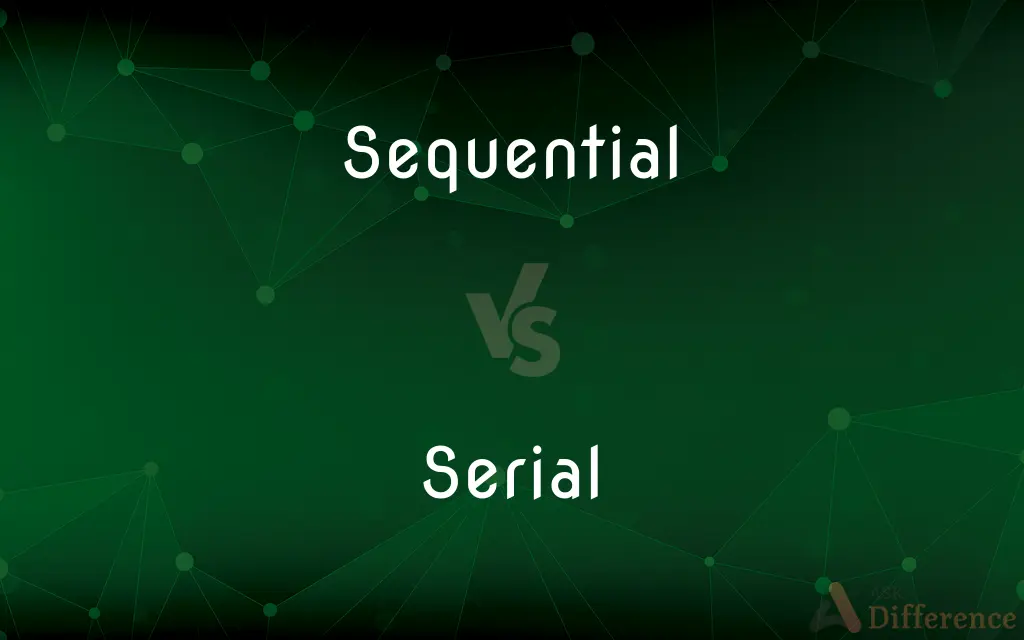Sequential vs. Serial — What's the Difference?
By Urooj Arif & Maham Liaqat — Updated on March 12, 2024
Sequential processing involves tasks performed in a specific order, one after another, whereas serial processing refers to the execution of tasks in a sequence but emphasizes the one-at-a-time aspect.

Difference Between Sequential and Serial
Table of Contents
ADVERTISEMENT
Key Differences
Sequential processing is characterized by the execution of tasks one after another in a specific order. This method is essential in scenarios where each step depends on the outcome of the previous one, ensuring that tasks are completed in a logical sequence. On the other hand, serial processing also involves tasks being performed one after the other, but it highlights the aspect of tasks being executed singly, without parallel processing, regardless of any specific order.
Sequential processing is often used in computer programming and data processing, where a series of commands must be executed in a certain order to achieve the desired outcome. Whereas serial processing is crucial in serial communication where data is transmitted one bit at a time, over a single channel, emphasizing the time-sequenced nature of data transmission.
In sequential processing, the emphasis is on the order and flow, making it suitable for algorithms and processes where the input of one step is the output of another. On the other hand, serial processing's emphasis on one-at-a-time execution makes it ideal for situations where data or tasks must be handled individually to prevent overlap and ensure integrity.
The efficiency of sequential processing is highly dependent on the complexity and interdependence of tasks, as it can lead to bottlenecks if a particular step takes too long. Serial processing, while also susceptible to delays, is particularly affected by the speed of individual task execution, as each task must be completed before the next can begin.
In practice, sequential processing is often contrasted with parallel processing, where multiple tasks are executed simultaneously. Serial processing, however, is a subset of sequential processing, focusing specifically on the serialized nature of execution, regardless of the tasks’ order.
ADVERTISEMENT
Comparison Chart
Definition
Execution of tasks one after another in a specific order.
Execution of tasks one after another, emphasizing one-at-a-time execution.
Emphasis
Order and logical sequence of tasks.
One-at-a-time execution, without parallelism.
Use Case
Algorithms where steps are interdependent.
Communication where data is transmitted bit by bit.
Dependency
The output of one task is the input for the next.
Tasks are independent, focusing on single-task execution.
Contrast With
Parallel processing, where tasks are performed simultaneously.
Parallel processing and multitasking, due to its singular focus.
Compare with Definitions
Sequential
Used in programming to ensure tasks are executed in logical steps.
A computer program compiles code in a sequential process.
Serial
Involves executing tasks one at a time in a sequence.
Serial communication sends data one bit after another.
Sequential
Relies on the completion of one task before starting another.
Assembly lines use sequential processing for efficient production.
Serial
Often used in computing to manage data transmission.
Serial ports transmit data serially to avoid data collision.
Sequential
Executing tasks in a specific, predetermined order.
Cooking recipes follow sequential processing to achieve the desired dish.
Serial
Essential for operations that require single-task focus.
A printer processes print jobs in a serial manner.
Sequential
Emphasizes logical flow and order dependency.
Storytelling involves sequential processing to convey the narrative effectively.
Serial
Highlighted in situations where parallel processing is not viable.
Some security protocols operate through serial processing for accuracy.
Sequential
Suitable for data processing where order matters.
Database transactions are often handled through sequential processing to maintain integrity.
Serial
Focuses on the individual execution of tasks.
Serial storytelling presents episodes one after another, maintaining audience focus.
Sequential
Forming or characterized by a sequence, as of units or musical notes.
Serial
Of, forming, or arranged in a series.
Sequential
Sequent.
Serial
Published or produced in installments, as a novel or television drama.
Sequential
Succeeding or following in order.
Serial
Relating to such publication or production.
Sequential
Expressing succession of events.
Serial
Relating to or engaging in a series of similar acts or behaviors
Serial arson.
A serial procrastinator.
Sequential
(programming) Executed as a sequence of instructions, without concurrency or parallelism.
Serial
(Music) Relating to or based on a row of tones, especially the 12 pitches of the chromatic scale.
Sequential
Succeeding or following in order.
Serial
Of or relating to the sequential transmission of all the bits of a byte over one wire
A serial port.
A serial printer.
Sequential
In regular succession without gaps;
Serial concerts
Serial
Of or relating to the sequential performance of multiple operations
Serial processing.
Serial
A work of entertainment, as in film or literature, published or produced in installments that usually contain a narrative thread or overarching theme; a series.
Serial
Having to do with or arranged in a series.
Serial
(of a person) Who performs a specified action or course of action repeatedly or regularly.
The serial killer had a string of victims across seven states.
He was a serial entrepreneur, always coming up with a new way to make cash.
Serial
Published or produced in installments.
Serial
(grammar) Of or relating to a grammatical aspect relating to an action that is habitual and ongoing.
Serial
A work, such as a work of fiction, published in installments, often numbered and without a specified end.
Serial
A publication issued in successive parts, often numbered and with no predetermined end.
Serial
A serial number, esp. one required to activate software.
Go to these sites for serials, cracks and keygens.
Serial
(UK) A unit of police officers equipped with shields to tackle a riot.
Serial
(transitive) to assign a serial number to (especially of aircraft)
Serial
Of or pertaining to a series; consisting of a series; appearing in successive parts or numbers; as, a serial work or publication.
Serial
Of or pertaining to rows.
Serial
A publication appearing in a series or succession of part; a tale, or other writing, published in successive numbers of a periodical.
Serial
A serialized set of programs;
A comedy series
The Masterworks concert series
Serial
A periodical that appears at scheduled times
Serial
In regular succession without gaps;
Serial concerts
Serial
Pertaining to or composed in serial technique;
Serial music
Serial
Pertaining to or occurring in or producing a series;
Serial monogamy
Serial killing
A serial killer
Serial publication
Serial
Of or relating to the sequential performance of multiple operations;
Serial processing
Common Curiosities
What is sequential processing?
Sequential processing is the execution of tasks in a specific order, where each task depends on the completion of the previous one.
What defines serial processing?
Serial processing involves executing tasks one after another, with a focus on one-at-a-time execution without parallelism.
Can sequential processing involve parallel tasks?
No, sequential processing involves tasks being executed one after another, not simultaneously.
Is serial processing dependent on task order?
Not necessarily; serial processing emphasizes the single-task focus rather than the specific order of tasks.
How do sequential and serial processing differ in emphasis?
Sequential processing emphasizes the order and logical sequence, while serial processing highlights the one-at-a-time execution.
What are common use cases for sequential processing?
Algorithms where steps are interdependent and data processing where order is crucial.
How do sequential and serial processing relate to parallel processing?
Sequential processing contrasts with parallel processing, where tasks are performed simultaneously, while serial processing is a subset of sequential that focuses on one-at-a-time execution.
What is a key limitation of serial processing?
Its efficiency is affected by the speed of individual task execution since each task must be completed before the next begins.
Where is serial processing typically used?
In serial communication for data transmission and situations requiring single-task attention.
How does sequential processing handle task dependencies?
It relies on the output of one task as the input for the next, ensuring a logical flow.
What is a drawback of sequential processing?
It can lead to bottlenecks if one step in the sequence is significantly slower than others.
Why might someone choose serial processing over parallel processing?
For tasks that require undivided attention to each step to prevent errors or when dealing with limited resources.
Can serial processing improve data integrity?
Yes, by handling tasks individually, it ensures data is processed accurately and without overlap.
Is sequential processing suitable for all types of tasks?
No, it's best for tasks that are logically interconnected and where the order of execution is crucial.
How does the efficiency of sequential processing compare with serial processing?
Efficiency in sequential processing depends on task complexity and interdependence, while in serial processing, it depends on the speed of individual task execution.
Share Your Discovery

Previous Comparison
Critical vs. Quarrelsome
Next Comparison
Cloud vs. BlurAuthor Spotlight
Written by
Urooj ArifUrooj is a skilled content writer at Ask Difference, known for her exceptional ability to simplify complex topics into engaging and informative content. With a passion for research and a flair for clear, concise writing, she consistently delivers articles that resonate with our diverse audience.
Co-written by
Maham Liaqat













































